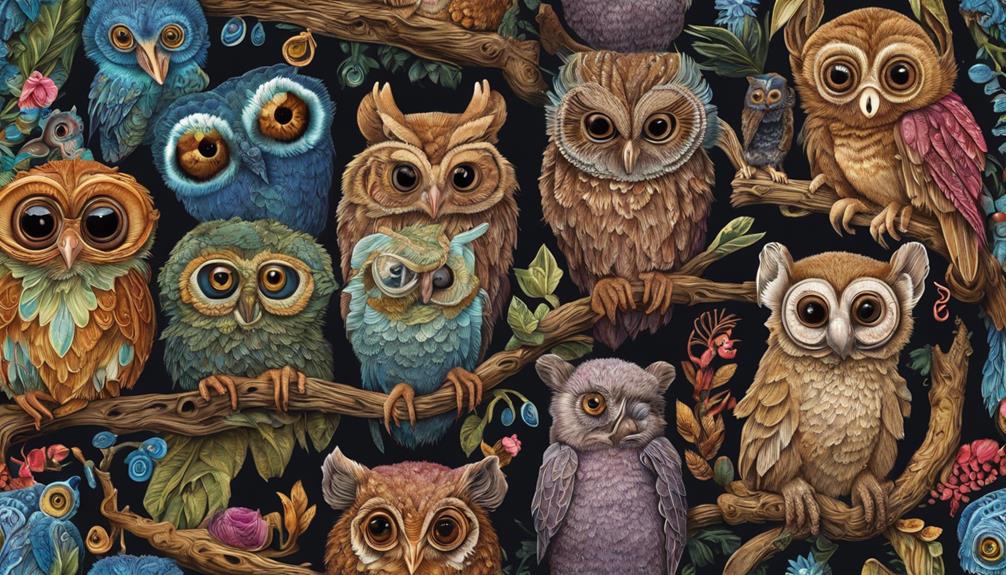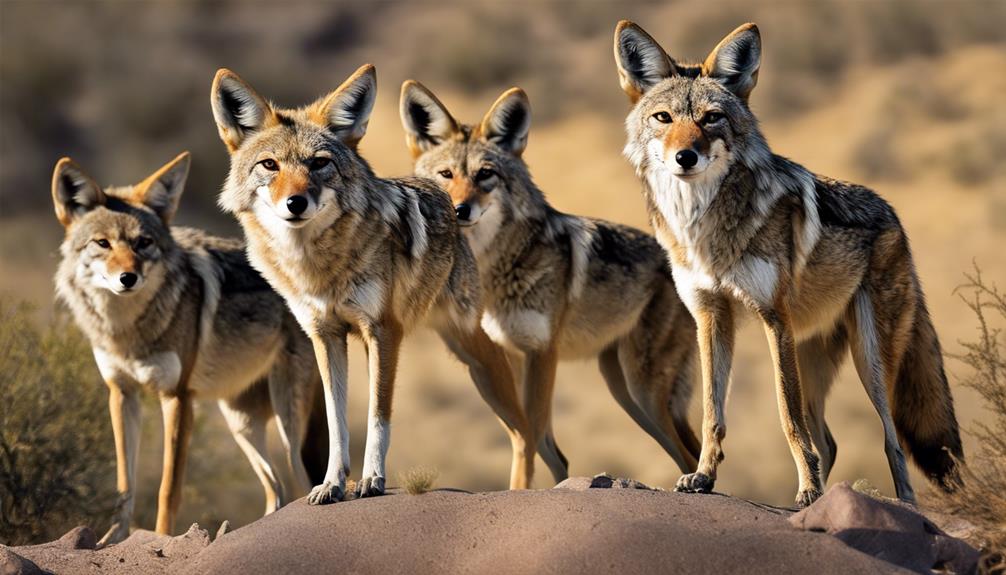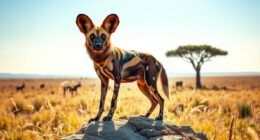Did you know that lions and hyenas are not only competitors, but they also have lethal confrontations for survival in their natural habitat? Even though they inhabit the same surroundings and vie for the same resources, the interaction between these top predators is more intricate than it appears.
Contrary to popular belief, lions do not consider hyenas as a desirable source of food. In fact, hyena flesh is not highly nutritious, which makes them an unappealing prey option for lions. So, why do these majestic big cats occasionally kill hyenas?
In this article, we will delve into the dynamic world of lions and hyenas, exploring the predator-prey dynamics, the competition for food, and the surprising truths behind these iconic species. Get ready to uncover the fascinating facts about their relationship and shed light on the mysteries of the wild.
Key Takeaways:
- Lions do not see hyenas as a desirable food source due to the lack of nutrition in hyena flesh.
- Lions primarily kill hyenas to reduce competition for food and protect their territory.
- Hyenas have proven to be skilled hunters and not just scavengers.
- Hyenas display remarkable problem-solving skills and exhibit high intelligence.
- The unique biology and social structure of hyenas contribute to their success and abundance in different African habitats.
The Competition for Food
When it comes to the food chain in the wild, lions and hyenas are both apex predators competing for survival. While they often scavenge for the same remains, the competition between lions and hyenas extends beyond scavenging behavior.
Field studies have revealed that lions have a tendency to steal more kills from hyenas than vice versa. This can be attributed to the hunting prowess and strength of lions, which gives them an advantage in overpowering and claiming the prey.
Although hunting hyenas is not a top priority for lions, hyena groups can pose a threat to unprotected lion cubs and isolated lions. In fact, the majority of hyena deaths are caused by lion attacks, highlighting the intense rivalry and territorial battles between the two species.
While lions prefer to hunt and secure their own kills, they are not averse to scavenging when the opportunity arises. Similarly, hyenas are opportunistic predators that scavenge and hunt depending on the availability of prey. This constant competition for food has shaped the dynamics between lions and hyenas in the wild.
The Scavenging Behavior of Lions and Hyenas
“For the scavenger, nothing goes to waste.”
Both lions and hyenas play important roles in the ecosystem as scavengers, ensuring that no food is wasted. Lions scavenge more kills from hyenas due to their dominance and ability to overpower their competitors. However, hyenas have also been observed scavenging from lions on occasion.
“Sometimes, even the mighty must rely on the leftovers of others.”
As scavengers, both lions and hyenas benefit from the kills made by other predators. This behavior allows them to conserve energy by feeding on already downed prey. By scavenging, they contribute to the balance of the food chain in the wild.
“Competition for food is a way of life in the wild.”
The competition between lions and hyenas is a testament to the fierce nature of the wild. While they may clash over resources, this rivalry plays a crucial role in maintaining the delicate equilibrium of the ecosystem.
| Lions | Hyenas | |
|---|---|---|
| Primary Food Source | Freshly hunted prey | Freshly hunted prey |
| Scavenging Behavior | Opportunistic scavengers | Opportunistic scavengers |
| Scavenged Kills from Competitor | More steals from hyenas | Sometimes scavenges from lions |
| Competition Intensity | High, especially for territory | Intense, especially with lions |
“In the circle of life, competition fuels survival.”
The competition for food between lions and hyenas exemplifies the intricate workings of the wild. Their constant struggle for resources showcases the remarkable adaptability and resilience of both species.
Why Lions Don’t Eat Hyenas
When it comes to the dining preferences of lions, hyena meat doesn’t make the cut. Despite sharing the same African savannah and engaging in territorial battles, lions view hyenas more as competitors than as a desirable food source. Biologists have discovered that hyena flesh lacks the necessary nutrition to sustain lions, leading them to seek alternative prey.
One reason why lions abstain from consuming hyenas is the taste of their meat. Hyenas are known to store some of their prey’s carcasses in water graves, allowing the meat to rot. This peculiar behavior gives hyena flesh an unpleasant taste, resulting in lions often choosing to forgo the consumption of their fallen rivals.
Additionally, lions strategically kill hyenas to reduce competition for food and protect their territory rather than for their nutritional value. Lions are opportunistic hunters and prioritize fresh kills that provide them with substantial sustenance. As a result, the choice to target hyenas serves as a strategic move to limit the competition for valuable food resources.

The Myth of Hyenas as Scavengers
While hyenas are often depicted as scavengers, they are not the top scavengers in Africa. Wildlife biologists have observed that lions scavenge more kills than hyenas. Like many other carnivores, hyenas will consume carrion if it’s readily available. However, their diet mainly consists of fresh kills from hunting, with scavenging playing a minor role. Hyenas’ ability to eat every part of a carcass, including the bones, has led to their association with gluttony.
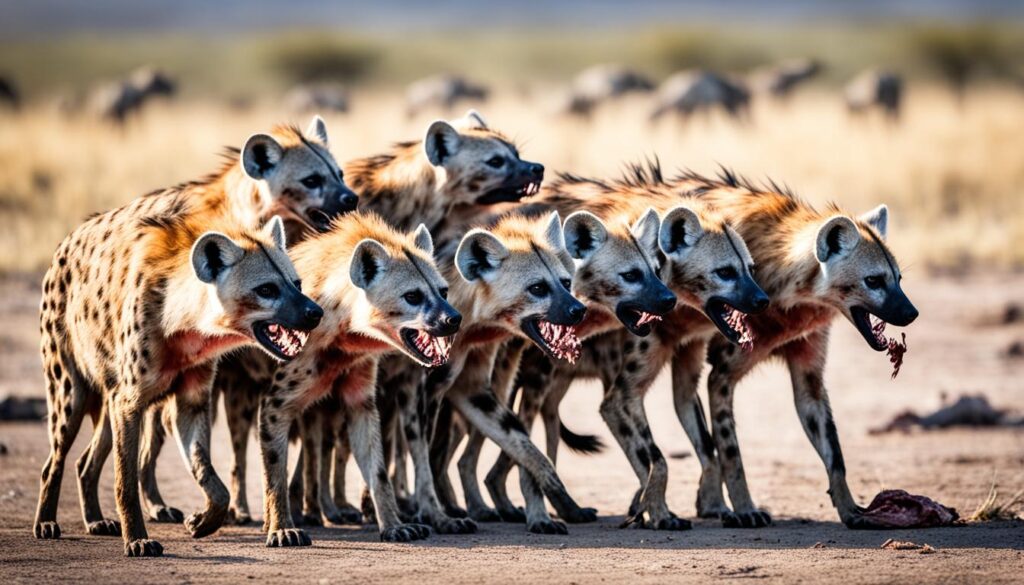
Contrary to popular belief, hyenas are not the primary scavengers in the wild. Research has shown that lions scavenge more kills than hyenas. While hyenas will consume carrion if it’s easily accessible, their diet primarily consists of fresh kills from hunting rather than scavenging. However, their remarkable adaptability allows them to consume all parts of a carcass, including bones. This ability has led to an association between hyenas and gluttony.
The Matrilineal Society of Hyenas
Hyenas have a fascinating social structure that revolves around matrilineal dominance and the inheritance of rank within their society. In hyena society, it is the mother who determines the rank of her offspring, leading to a unique and matriarchal hierarchy.
Females play a dominant role in hyena society, holding the highest positions in the social order. They exhibit a level of dominance and assertiveness that surpasses their male counterparts. This matrilineal system ensures that females have the power to shape the hierarchy and dictate the dynamics within the group.
Both male and female hyenas inherit the rank of their mother, solidifying the matriarchal lineage within the society. However, while females tend to stay within their birth clans, males often leave to find new mates and establish themselves in other groups. This dispersal of males helps prevent inbreeding and promotes genetic diversity among hyenas.
The matrilineal society of hyenas has played a vital role in their success and abundance as the most common large carnivore in Africa. By establishing strong bonds among related females and passing down dominant positions through generations, hyenas have managed to thrive in various habitats across the continent.
Image:
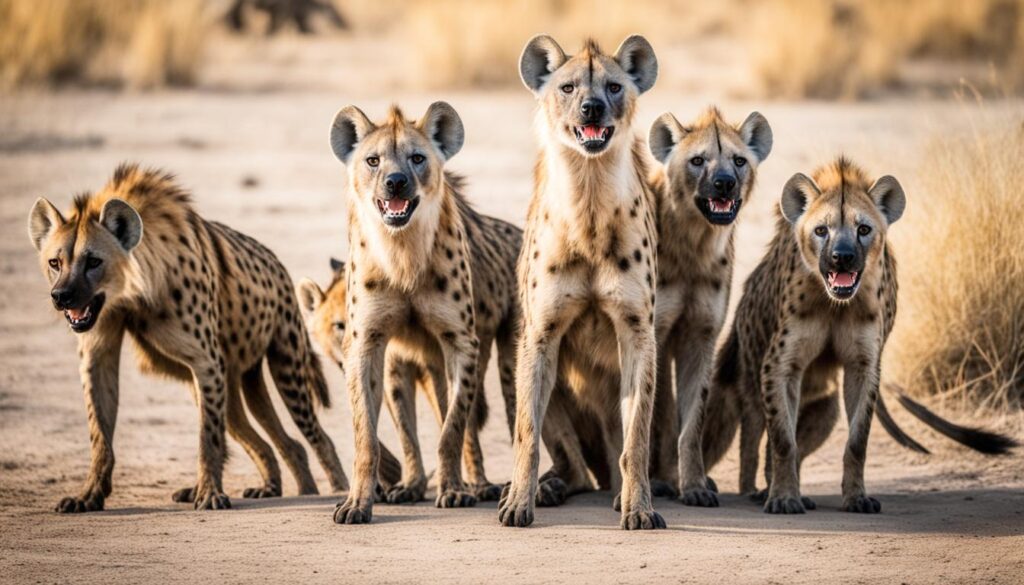
Intelligence and Behavior of Hyenas
Hyenas are fascinating creatures with exceptional intelligence and problem-solving skills. In fact, they are believed to be as smart as primates, defying the stereotypes associated with their scavenger reputation. Observations have shown that hyenas possess remarkable problem-solving abilities, such as opening latches and solving puzzles, which demonstrate their cognitive flexibility and adaptability.
One of the key traits that sets hyenas apart is their adaptability as predators. They have the unique ability to hunt a wide range of prey, from small mammals to large herbivores. Their hunting techniques often involve working together, as they exhibit fission-fusion societies. This means that hyena groups can merge or split depending on the situation, allowing them to be more agile and efficient in their hunting strategies.
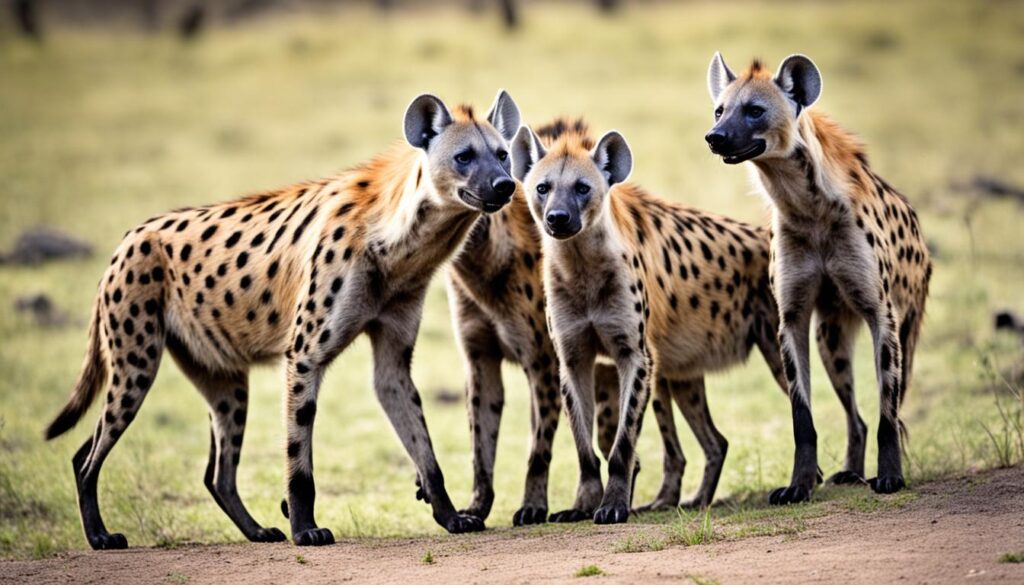
Innovation and Problem-Solving Abilities
Recent studies have revealed intriguing insights into the behavior of hyenas in different environments. Research has shown that hyenas in rural areas display greater innovation and problem-solving abilities compared to their counterparts in urban settings. This suggests that the challenges of surviving in a constantly changing natural landscape enhance their cognitive skills.
“Hyenas are highly intelligent animals and possess remarkable problem-solving abilities.”
The Adaptive Nature of Hyenas
The adaptability of hyenas extends beyond their hunting abilities. They have demonstrated an impressive ability to thrive in various habitats, including deserts, forests, and even urban areas. This adaptability is crucial for their survival, as it allows them to exploit new food sources and respond to changing environmental conditions. Whether they are adapting to the harsh arid landscapes of the African savannah or thriving alongside humans in urban environments, hyenas showcase their remarkable ability to navigate diverse ecosystems.
Hunting Strategies and Group Dynamics
Hyenas employ complex and coordinated hunting strategies, disproving the misconception that they are solely scavengers. These intelligent predators work together to take down large prey, such as wildebeests, zebras, and buffalos. While the exact mechanisms of their hunting techniques remain a mystery, ongoing research utilizing GPS collars and AI algorithms is shedding light on their movements and vocalizations during hunts.
Hunting Abilities of Hyenas
Contrary to popular belief, hyenas are skilled hunters and not just scavengers. In areas like the Masai Mara, hyenas primarily rely on hunting for their food, often working together to take down large prey such as wildebeests, zebras, and buffalos. The exact mechanisms of their hunting strategies are still a mystery, but researchers are using GPS collars and AI algorithms to study their movements and vocalizations during hunts.
Cooperative hunting is a key aspect of hyena hunting behavior. Hyenas live in social groups called clans, which can consist of up to 80 individuals led by dominant females. These clans work together to strategize and execute their takedowns of large prey, ensuring a successful hunt.
The hunting process typically begins with the hyenas locating a potential target, using their acute senses of sight and hearing. Once the target is identified, the clan members coordinate their actions, surrounding the prey and initiating a coordinated attack. This cooperative strategy allows them to overpower large herbivores that would be challenging to bring down individually.
To communicate during the hunt, hyenas use vocalizations such as whoops, growls, and cackles. These vocal cues help coordinate their movements and maintain group cohesion. Researchers are studying these vocalizations to gain insights into the hunting strategies and coordination within hyena clans.
“Hyenas are highly adaptable hunters, using their intelligence and teamwork to secure their food sources. Their hunting behavior challenges the common perception of hyenas as scavengers and highlights the complex dynamics within their clans.”
While their hunting prowess is impressive, hyenas are also opportunistic scavengers. They can make use of carcasses left behind by other predators, further enhancing their survival in the wild.
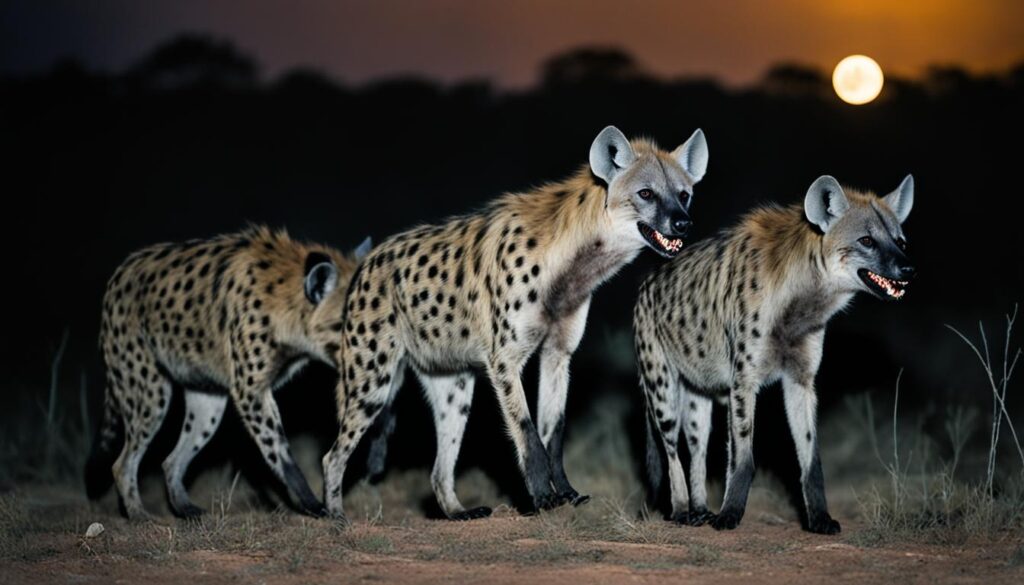
The Role of Large Prey Takedowns
Large prey takedowns play a crucial role in the survival and sustenance of hyena clans. Taking down a large herbivore provides an abundant source of food that can feed the entire clan for several days. This helps ensure the survival of both dominant and subordinate members, contributing to the stability and success of the clan.
Furthermore, hyenas’ hunting abilities have a significant impact on the ecosystem. By preying on large herbivores, they help regulate herbivore populations, prevent overgrazing, and maintain a balance in the predator-prey dynamics within their habitat.
Implications for Wildlife Conservation
Understanding hyenas’ hunting abilities and their role as predators is crucial for wildlife conservation efforts. By dispelling misconceptions and highlighting their hunting skills, researchers and conservationists can foster greater appreciation for these fascinating creatures and advocate for their protection.
Furthermore, studying hyenas’ hunting behavior can provide valuable insights into predator-prey dynamics and cooperative strategies. These insights can be applied to conservation strategies aimed at preserving other vulnerable species and maintaining the delicate balance of ecosystems.
The Unique Biology of Female Spotted Hyenas
Female spotted hyenas possess a fascinating and distinctive reproductive anatomy that sets them apart from other mammals. One notable feature is their elongated clitoris, which bears a striking resemblance to a male’s penis. During mating, the female hyena retracts this pseudo-penis and has the autonomy to choose which male can mate with her. This unique reproductive system distinguishes female hyenas from their counterparts in the animal kingdom.
Female spotted hyenas also give birth through their clitoris, making it a truly remarkable adaptation. This unconventional method of birth showcases the extraordinary capacity of female hyenas to deliver offspring using their elongated clitoris. It is a testament to the biological ingenuity of these remarkable creatures.
Beyond their distinctive reproductive biology, female spotted hyenas exhibit remarkable maternal care towards their offspring. These hyenas engage in extended parental care, nursing their young for over a year. This prolonged period of maternal dedication contributes to the development of their aggressive and dominant behavior, shaping the social dynamics of hyena society.
The Remarkable Reproductive Adaptations of Female Spotted Hyenas
“The elongated clitoris of female spotted hyenas and their ability to give birth through it are remarkable examples of the unique reproductive adaptations in the animal kingdom.”
Dr. Jane Miller, Wildlife Biologist
The commitment of female hyenas to their offspring is evident in their extended nursing period. By providing nourishment and guidance for an extended duration, female hyenas contribute to the rearing and development of their young, preparing them for the challenges they will face as they grow.
Overall, the unique biology of female spotted hyenas, including their elongated clitoris and maternal care, showcases the exceptional adaptability and evolutionary strategies of these remarkable creatures.

Hyenas’ Adaptability to Different Environments
Hyenas are incredible predators that have proven their ability to thrive in a wide range of habitats across Africa. From the arid deserts to lush forests and even urban cities, hyenas have successfully adapted to diverse environments, showcasing their remarkable resilience.
One of the key factors contributing to hyenas’ success across various habitats is their cognitive abilities and problem-solving skills. Studies have shown that hyenas possess a high level of intelligence, rivaling that of primates. They have the ability to remember and learn from past experiences, allowing them to adapt their hunting strategies and problem-solving techniques when faced with new challenges.
“Hyenas exhibit impressive cognitive abilities and can remember how to solve problems, exhibit innovative thinking, and even outperform some primate species in certain tasks,” says Dr. Jane Wilson, a renowned wildlife biologist.
Hyenas’ unique combination of intelligence and adaptability has allowed them to become one of the most abundant large carnivores in Africa. They have mastered the art of survival, utilizing their cognitive abilities to navigate and thrive in ever-changing environments.
To further illustrate their adaptability, here are a few examples of hyena habitats:
| Habitat | Description |
|---|---|
| Savannah Grasslands | Hyenas are commonly found in savannah grasslands, where they track and hunt large herbivores like wildebeests and zebras. |
| Deserts | Hyenas have proven their ability to survive in harsh desert environments, relying on scavenging and hunting small desert-dwelling animals. |
| Woodlands | Hyenas have successfully adapted to woodland habitats by utilizing their problem-solving skills to track and hunt smaller prey in dense vegetation. |
| Urban Areas | Surprisingly, hyenas have even adapted to urban environments, where they scavenge on human waste and prey on smaller animals that occupy these areas. |
Hyenas’ ability to thrive in such diverse habitats speaks to their remarkable adaptability and resourcefulness. This adaptability has allowed them to establish a stable presence in ecosystems worldwide, making them one of Africa’s most successful and abundant large carnivores.
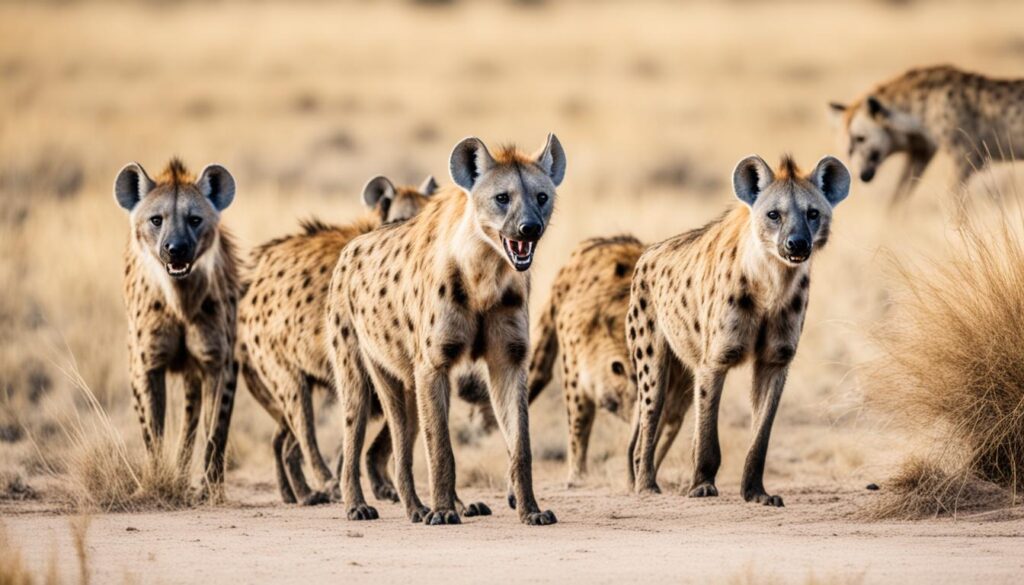
Conclusion
The relationship between lions and hyenas in the wild is fascinating, characterized by complex dynamics and intense competition. Both species, considered apex predators, vie for the same resources, leading to territorial battles and the need to secure their food supply.
Contrary to popular belief, lions do not primarily rely on hyenas as a food source. While occasional predation may occur, hyenas are not their preferred prey. Instead, the rivalry between lions and hyenas is driven by the need to protect territory and secure dominance in the ecosystem.
Hyenas, often misunderstood as mere scavengers, display remarkable hunting abilities and intelligence. They challenge the conventional perception of their role in the prey-predator interactions. Hyenas are skilled hunters, known for their cooperative tactics and strategic takedowns of large prey, such as wildebeests and zebras.
The success and abundance of hyenas can be attributed to their unique biology and social structure. Female hyenas hold dominant positions in their matrilineal society, passing down their rank to offspring. Additionally, their adaptability to various African habitats, combined with their cognitive abilities, allows them to thrive and adjust to changing environments.



